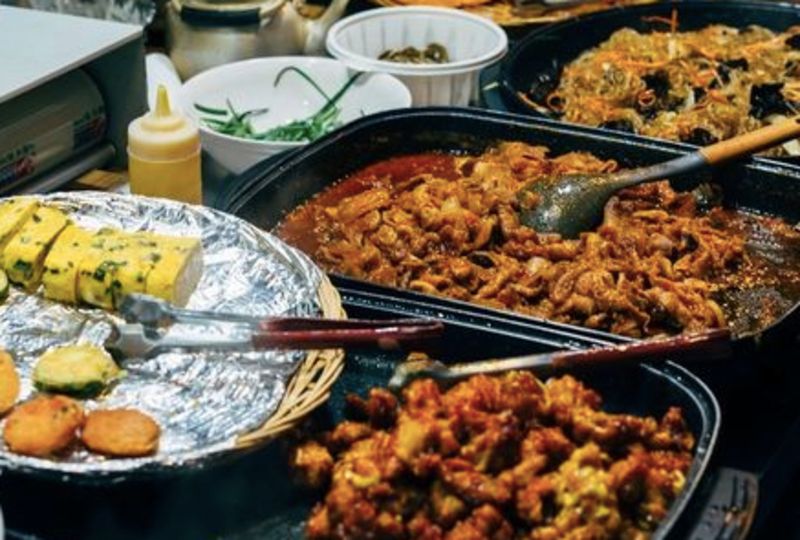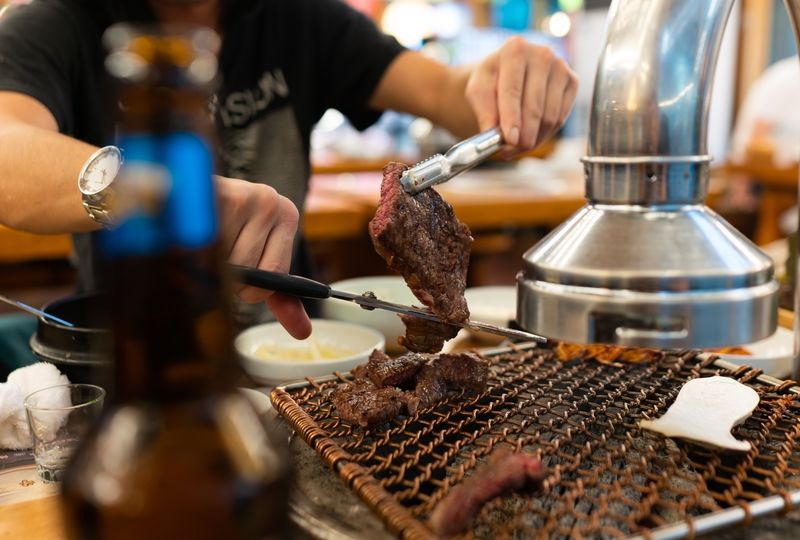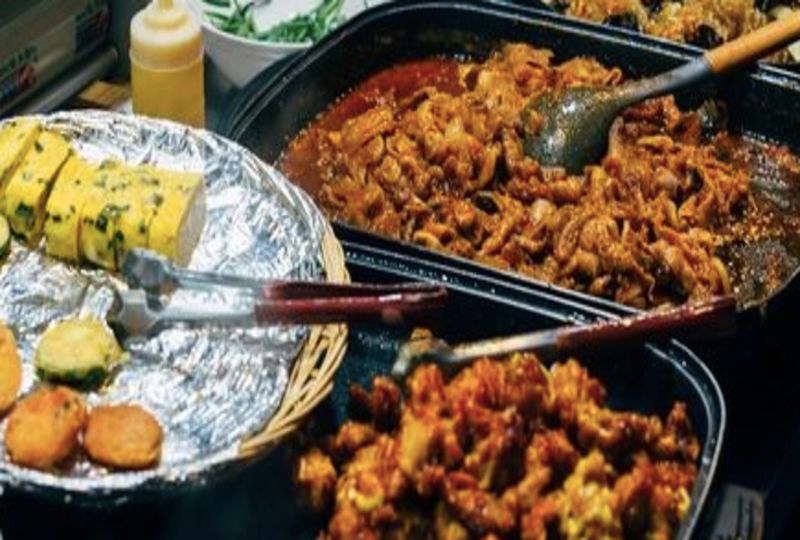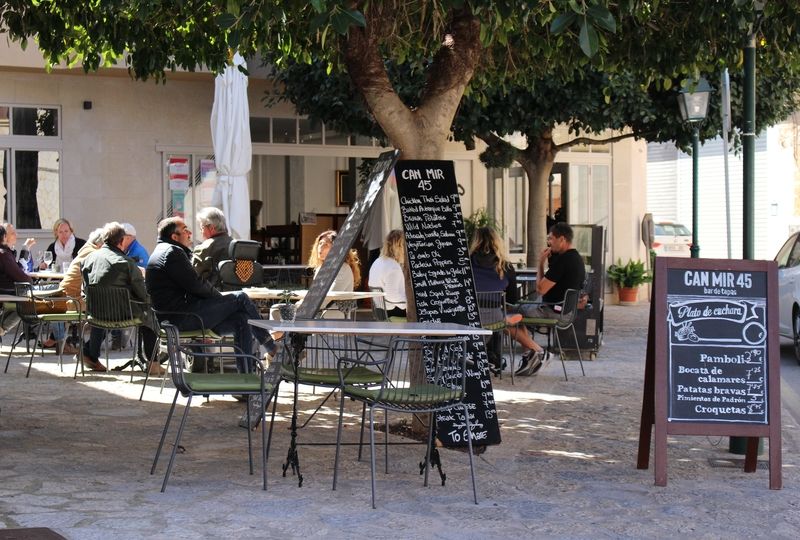Learn Korean Dining Vocabulary: How to Order Korean BBQ in Korean and More

It’s no surprise that over the last three years, Korean barbecue has reached a rate of being one of the fastest growing dining trends in America. Learning how to pronounce the different foods off of the menu and properly address certain requests to the waiter is a must-know! Getting to try food is such a fun, rewarding way to learn a language.Since Korean BBQ is so famous, why not learn Korean while enjoying delicious Korean BBQ?! We will be going over the culture of this Asian dining experience and how to learn Korean words and phrases that will most likely be brought up during a KBBQ feast.

What is "Korean BBQ"?
Korean BBQ is known to and said by Koreans as 고기구이 (gogi-goo-ui), which translates to "grilled meat". The first part of the phrase is it's own word; 고기 (gogi) which means "meat". The second part, 구이 (goo-ui), means "grill/roast". Together,고기구이 (gogi-goo-ui) describes exactly what Korean Barbecuing is!
What to expect when dining at a Korean barbecue is a grill on the middle of your table, cooking all sorts of meats of your choice right before your eyes. Scissors are provided so that you can cut your own pieces of cooking meat to the size of your choice. Then, you are able to take it off the burner and place it right onto your plate yourself, fresh and ready to eat right then and there! A great example to watch is this short documentary on one's Asian dining experience.
Also nicknamed “K-BBQ” for short, this Asian food consists of different choices of meat, cooked with a delicious combination of flavorful spices that pair with Korean sauces. And the best part of all… unlimited 반찬 (Banchan)!
Do not be alarmed when the large amount of 반찬 (ban-chan) comes out. Banchan is a name for Korean side dishes, and many of these accompany the barbecued meats. Plus, they do not cost extra... As a matter of fact, they come with the meal! Think fermented vegetables and all sorts of kimchi... These are some of the side dishes to expect with your Korean barbecue feast.
When it comes to Asian food, some of the most popular meats of choice are
불고기, Bulgogi, pronounced (bul·gow·gee) and 갈비, Kalbi, (gal-bee). You can certainly find these meats at most Korean restaurants, and these are especially popular to order when dining at a Korean barbecue! Definitely worth a try if you are not sure which meats to choose to start with.

Ordering off the Menu in Korean
Eating at a Korean restaurant is an effective way of acquainting yourself with the culture. Not only will you have real, in-person practice through this way of immersing yourself, but you will also get to enjoy all the wonderful foods that come with it! Here are the most common and simple ways to order your food in Korean:
- 이거 주세요. (ee-guh ju-se-yo) – “Please give this / I’ll have this”. This is the simplest way to ask for it.
Let’s break it down: 이거 (ee-guh) means “this” while 주세요 (ju-se-yo) means “please give”. Although the order of the words in English comes out to the sentence saying “This please give”, it translates into the proper order of “Please give this / I’ll have this”, when used in Korean translation.
If you would like to get more specific with what it is you are ordering, then you can say this sentence:
2. “물 주세요 (mul ju-se-yo).
물 means "water" in Korean. This is just an example sentence, but as long as you make sure to put whichever food it is that you'd like to order into the first part of that sentence, you can correctly end it off with saying 주세요 (ju-se-yo)!
Notice that the ending of this sentence is the same as the one above in example 1? We are replacing the word “this” into a more specific selection. By putting the name of the food in the place of such a broad word such as (ee-guh) “this”, you are now saying the name of the food you are ordering and adding 주세요 (ju-se-yo) “Please give” to the end of the sentence! This is basically saying the prior phrase in number 1.’s example, but replacing 이거 with the name of the food.
If you want to add something else to your order, which is highly likely considering how many tasty options there are, then there is Another phrase that may come in handy. You can say:
3. 더 주세요. ( duh ju-se-yo) AKA Please give more of ____.
This will ensure you successfully ask for another item on the menu! Simply point to what it is you want more of, or refer to the different meat vocabulary below.
Learning how to order this sought-after meal and cater the experience to your taste bud preferences will highly enhance your experience of Korean culture. It is highly rewarding to master how to order food in Korean!

Learning Korean BBQ Meats
As the main course of the meal, there is commonly a list of meats that you can choose from, usually with an All-You-Can-Eat buffet style. You will just keep getting served the various meat onto your barbecue grill until you are too full for any more! Here are the most common meats that are offered at Korean barbeque restaurants:
-
불고기 “Bulgogi” (bul-gow-gee): This literally translates to ‘Fire Meat’! It’s no wonder that it is represented as such a popular KBBQ serving. Bulgogi comes as beef that is thinly sliced and basked in marinated flavorings of sweet and soy taste.
-
갈비 “Kalbi” (gal-bee): These are grilled ribs marinated in sweet soy flavors. The most commonly used meat for this is beef short ribs. The taste of them is slightly similar to Bulgogi, but the types and textures of these two meats is what sets them apart.
-
양지머리 “Brisket” (yang-ji-meo-li): This brisket is thinly sliced and not marinated, which brings out a salty, smokier flavor.
-
삼겹살 “Pork Belly” (Sam-gyup-sal): Pork belly comes in many popular marinades, including spicy, garlic, miso, red wine, and even non-marinated! The texture is more on the thicker, chewier side.
The list goes on for the different options you can BBQ, although these are the most popular meats of choice when it comes to ordering Korean BBQ.

How to Learn Korean Language Food Requests
If you are in need of vegetarian options, then this is a key phrase to say:
채식 메뉴 있어요? (che-shik-meh-nyu ee-ssuh-yo) – Do you have a vegetarian menu?
Let’s break this one down to understand the sentence! First off, 채식 means vegetarianism. 메뉴 is “Menu”, and 있어요 is “Do you have”. Again, if reading it in order, it sounds like the words are in the wrong arrangement but it will translate correctly to the appropriate question!
Korean cuisines are full of nutritious foods and exotic tastes. If you are aiming for a vegetarian meal, you are in no way missing out on the flavorful experience of this culture. There are so many noodle dishes, soups and stews to choose from! All of them are so full of hearty ingredients, you will have no problem with finding a delicious vegetarian option.
If you are in need of a gluten free option, you can say something that is very similar to the phrase mentioned above:
글루텐 프리 메뉴 있어요 (geulluten peuli menyu iss-eoyo) - Do you have a gluten free menu?
Here’s another request that can come in handy...
안 맵게 해 주세요. (ahn-mep-geh heh-ju-se-yo) – Please don’t make it spicy.
Anyone else out there sensitive to spicy food?! The heat can be overwhelming to some people, and Koreans certainly use all kinds of spice -- many being very hot or with a kick. There are so many different spicy foods this country is popular for! It is not at all impolite to want less spicy-ness on your dish, so you can make the request to your server by saying the Korean sentence above.
So, let’s say that you don’t need vegetarian or gluten free menus. There could still be certain food modifications that are necessary for you, and in the case of allergens, you will want to let your server know what you can’t consume.
This is the phrase to express what it is you are allergic to:
저 _____ 알레르기 있어요. ( juh _____ ahl-leh-leu-gi ee-ssuh-yo) – I am allergic to ______.
Simply fill in the first blank with the food you are allergic to. Below are a few common allergens translated to Korean language:
땅콩 (ddang-kong) – peanuts
간장 (gan-jang) -- soy
달걀 (dal-gyal) – egg
우유 (ooh-yoo) – milk
조개 (jo-gae) – shellfish
For example, if you were allergic to milk and wanted to let your server know, then you would fill in the blanks of the sentence above like this:
저 우유 알레르기 있어요. ( juh ooh-yoo ahl-leh-leu-gi ee-ssuh-yo) - I am allergic to milk.

Korean Dining Culture
Just like any other existing culture, Korean society holds their own values that may be different from what you are used to seeing and living through in your own area. With their infamous K-Pop music industry to the modern Korean slang that the country natively speaks, each culture holds different traditions and standards of communicating. You will want to know how to express proper dining manners when you embark on experiencing Korean food. Now that you have the basic phrases down, you can successfully participate in correctly ordering and eating Korean dining!
If you are ready to take your Korean cultural knowledge a step further, there are many resources that guide you in learning how to retain foreign language overall.
